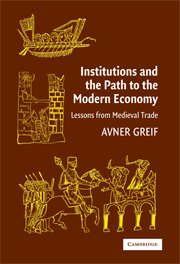Book contents
- Frontmatter
- Contents
- Abbreviations
- Preface
- I Preliminaries
- II Institutions as Systems in Equilibria
- III Institutional Dynamics as a Historical Process
- IV The Empirical Method of Comparative and Historical Institutional Analysis
- V Concluding Comments
- Appendixes
- References
- Index
- POLITICAL ECONOMY OF INSTITUTIONS AND DECISIONS
III - Institutional Dynamics as a Historical Process
Published online by Cambridge University Press: 05 September 2012
- Frontmatter
- Contents
- Abbreviations
- Preface
- I Preliminaries
- II Institutions as Systems in Equilibria
- III Institutional Dynamics as a Historical Process
- IV The Empirical Method of Comparative and Historical Institutional Analysis
- V Concluding Comments
- Appendixes
- References
- Index
- POLITICAL ECONOMY OF INSTITUTIONS AND DECISIONS
Summary
How does an institution persist in a changing environment? How do exogenous changes and the processes that an institution unleashes lead to the institution's demise? How do past institutions – perhaps even institutions that are no longer effective in influencing behavior – affect the direction of institutional change? Why do societies evolve along distinct institutional trajectories, and why is it so difficult to alter institutional dynamics to induce better outcomes?
These questions have long bedeviled institutional analysis in economics, political science, and sociology. Addressing them requires a framework that can accommodate both stability and change – a framework that can account for an institution's persistence and stability in a changing environment on the one hand and endogenous institutional changes and the limit on institutional persistence on the other. The framework must also facilitate studying why, how, and to what extent past institutions influence subsequent ones.
Since the 1970s economists have developed two perspectives – the intentionally created perspective and the evolutionary perspective – to study institutional dynamics. The intentionally created perspective postulates that institutions are intentionally established by forward-looking individuals to serve various functions. Institutional dynamics are best studied as reflecting responses to the functions the institutions serve (e.g., North 1981; O. Williamson 1985). Political economy models were found to be particularly useful in studying processes through which institutions are established and changed.
- Type
- Chapter
- Information
- Institutions and the Path to the Modern EconomyLessons from Medieval Trade, pp. 153 - 157Publisher: Cambridge University PressPrint publication year: 2006
- 1
- Cited by



